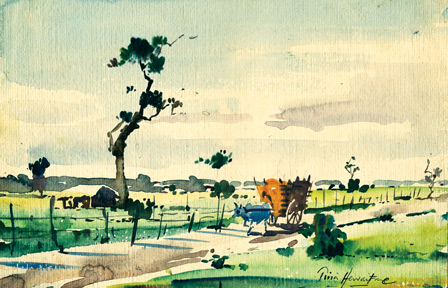Perspective in landscape painting
by Tissa Hewavitarane
The word perspective can be a frightening concept to some people who
are still learning to paint. Some students at first find perspective a
total mystery. In landscape painting, however, perspective is less of a
problem than it is, for instance, in drawing buildings. There is less
need to worry about linear perspective rather the need is to concentrate
on aerial perspective receding colours and tonal values which create the
illusion of space and depth.
The atmosphere through which we view the landscape is filled with
particles of dust and water vapour. These will seem to cast a blue-grey
veil over distant objects, and even over not-so-distant objects. As a
result they make the colour and also reduce surface detail. Colour
changes, therefore, as much as do lines and shapes.
Aerial perspective
This is one of the most useful techniques in watercolour and gives
the illusion of depth better than anything else. It is based on the
basic principle in nature that light tones seem to reduce into distance
whereas darker tones seem to come forward. The next important thing to
realise about recession is that objects also appear to contain more blue
the further distant they get.
The greens in grass and trees, for example, are quite pale at two
miles away and they get richer and warmer as they get nearer for the
viewer. One would be surprised how many art students seem to be unaware
of it or, at any rate, forget it as soon as they start painting.
|

A watercolour painting of a landscape. |
They see what is obviously a dark tree on the horizon about ten feet
away so they paint it in a strong dark tone, forgetting that there are
still about five layers of trees before the foreground is reached.
In other words they have used up their tonal 'big guns' in the
background and have nothing more powerful left for the foreground. The
same applies if too rich a green is used for a far distant field which
should have been held in reserve for a nearer one. I always suggest any
student to paint from the furthest distance, gradually moving forward in
planes to the foreground.
Counter change
Counter change is the placing of dark shapes against light ones, and
light shapes against dark. Basically, this is contrasting areas of dark
and light as on the chess board. This principle should be locked in your
mind all the time when you're painting, almost like a fighter waiting
for the opportunity to use his favourite punch. All the great masters
used this principle when they composed their work, but unless you're
aware of what's going on you probably accept it without appreciating it.
One would only realise how important it is when you see a painting
done by some one who hasn't yet learnt about counter change. A house may
be put next to a tree, with the same tone, even though they may be a
different colour and the only way they can be separated is by having to
draw a line on top to show up the edges which is incorrect.
What they should be doing instinctively is to darken the tree to show
up the edge of the house on darken that bit of the house where it comes
in front of the tree. The most obvious way of stressing the main centre
of interest can be achieved very dramatically by putting the darkest
dark in the picture against the light, such as the pure while sail of
yatch that just happens to be passing in front of a very dark tree.
The same principle should be at work in a less obvious way all over
the picture, but these things don't just happen by accident in a
painting, they have to be thought out before hand. Put the idea of
counter change into your brain permanently and use it at all times as
part of your armoury.
Trees
I have painted a simple landscape with trees to demonstrate the
effects of aerial perspective. In the distance trees are small, a flat
cool green is applied with no detail. In the middle ground I have added
green with a mixture of light wash of burnt sienna and have painted the
trees and bushes in two values, light and dark.
By using aerial perspective I have created an illusion of depth and
space on the paper.
When painting a landscape, it is vital to consider the weather. It is
of no use to paint the sky grey to portray a cloudy wet day and then to
paint the rest of the picture in bright colours as if it were sunny day.
The painting demonstrates the effects of light on the landscape. It
portrays a typical Sri Lankan landscape on a hot summer day. It also
demonstrates, as I have described aerial perspective.
To bring the foreground forward I used a very watery mixture of lemon
green with a layer of transparent glaze over the foreground to brighten
it. The colours I used in this painting are lemon green burnt sienna,
spa green orange and ultramarine blue.
Avoid thinking of yourself as a watercolourist. Your objective is not
to become the best artist of the medium of watercolour but to be the
best painter you can be. The solution is simply to have and maintain
your own sincerity. |

